Introduction
In the competitive landscape of stakeholder management, a well-crafted resume can be the key to unlocking new career opportunities. As organizations increasingly prioritize effective communication and relationship-building, professionals must showcase their skills in a way that resonates with hiring managers. This article delves into the essential stakeholder management skills to highlight, strategies for effectively presenting these competencies across different sections of a resume, and common pitfalls to avoid. By implementing actionable insights and quantifying achievements, candidates can position themselves as indispensable assets capable of navigating complex stakeholder environments and driving organizational success.
Key Stakeholder Management Skills to Highlight on Your Resume
When crafting your resume, it’s essential to emphasize the following key stakeholder management skills that are pivotal for success in these roles:
- Communication: Clearly articulate your ideas to various stakeholders, ensuring alignment and understanding. Effective communication is crucial, as 52% of survey respondents linked poor workplace communication to increased stress, and 70% noted wasted time as a cost of poor business communication. This highlights the need for clarity in interactions and the impact of communication on productivity.
- Negotiation: Showcase your ability to reach mutually beneficial agreements. Strong negotiation abilities can significantly influence project outcomes, driving success and enhancing relationships.
- Conflict Resolution: Demonstrate your expertise in mediating disputes and finding effective solutions. This ability is vital in maintaining harmony and productivity within teams.
- Relationship Building: Highlight your ability to establish and nurture professional relationships. According to the Achievers Workforce Institute, individuals who feel their employer takes meaningful action based on their feedback are 75% more likely to trust their leadership, underscoring the value of strong relationships. Additionally, utilizing effective communication channels, such as the intranet, which is the most used self-service channel at 84% with an effectiveness of 69%, can enhance these relationships.
- Strategic Thinking: Illustrate your capacity to align the interests of involved parties with organizational goals. This foresight is critical in ensuring that all parties are working towards a common vision.
These abilities are not merely jargon; they are essential in overseeing roles and ought to be prominently highlighted as stakeholder management resume bullet points. Furthermore, recognizing and celebrating individual and team successes can foster a positive work environment, as demonstrated in the case study titled "Celebrating Successes." By showcasing these competencies, you position yourself as a valuable asset in any organization, capable of navigating complex relationship dynamics.
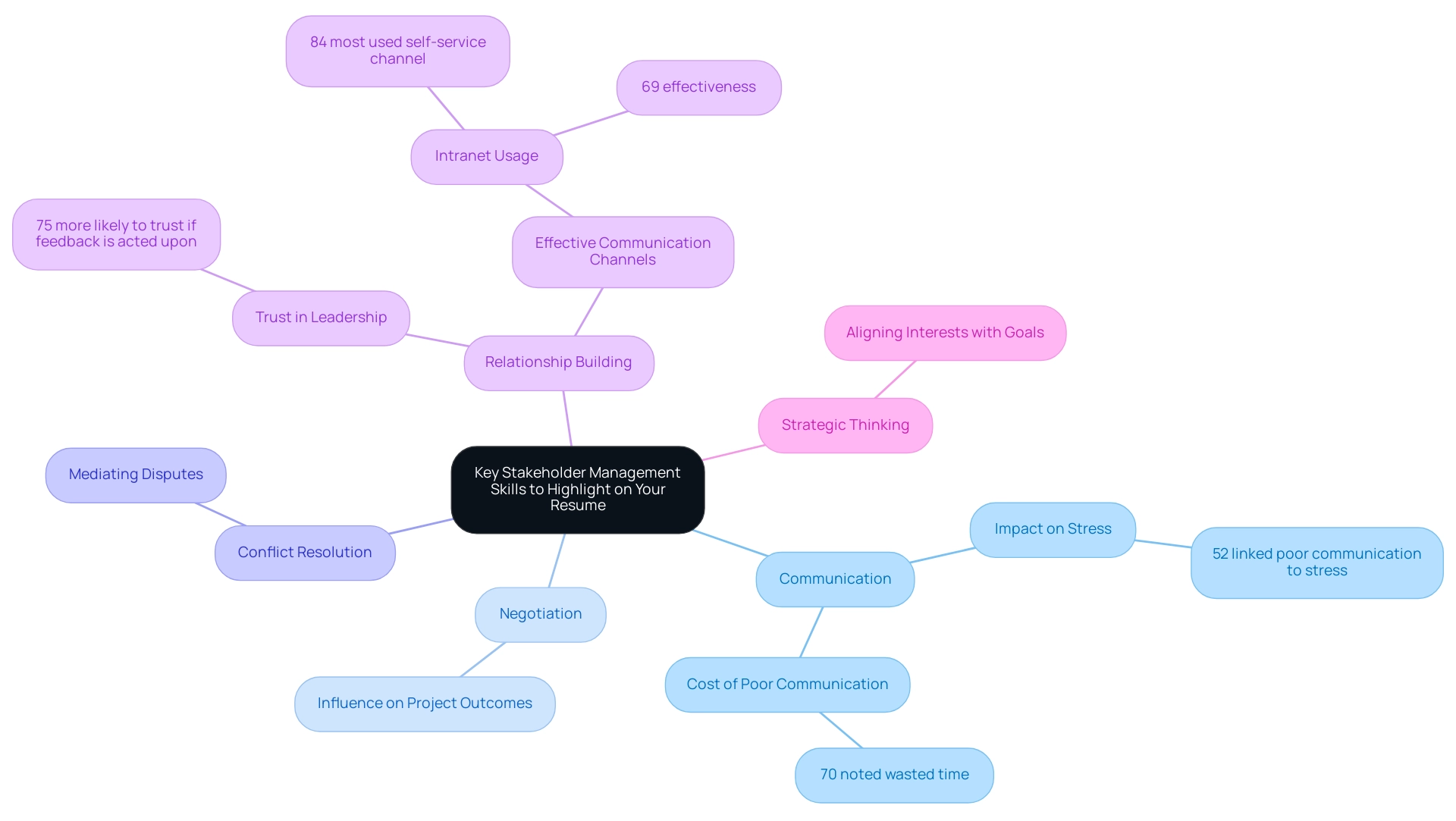
How to Showcase Stakeholder Management Skills in Your Resume Sections
To effectively highlight your skills in handling key relationships on your resume, adopt the following strategies across each section:
- Summary Section: Start with a compelling statement that encapsulates your experience in engaging with important parties. For instance, consider phrasing it as, 'Results-driven professional with over 10 years of experience in engagement and relationship management.' A strong summary statement significantly impacts job applications, with studies indicating a 4.94 average rating from nearly 4,000 evaluators, highlighting its effectiveness in grabbing attention.
- Experience Section: Utilize stakeholder management resume bullet points to delineate specific roles in which you successfully managed interested parties. For example, 'Led cross-functional teams to create effective stakeholder management resume bullet points that ensured project goals aligned with participant expectations, resulting in a 20% increase in project satisfaction ratings.' This clarity not only demonstrates your capabilities but also illustrates the tangible impact you have made in previous positions.
- Achievements Section: Quantify your successes to provide concrete evidence of your effectiveness. For instance, 'Developed and maintained relationships with important parties, contributing to a 15% increase in retention.' These metrics act as strong signs of your capacity to improve relationships with involved parties and project results.
Furthermore, examine job descriptions for roles related to stakeholder management resume bullet points to pinpoint pertinent abilities and customize your CV accordingly. Integrating hard skills like participant analysis, communication planning, risk oversight, and conflict resolution is crucial for effectively handling relationships with interested parties.
As a result of robust oversight of involved parties, 'we were able to win over participants, alleviate their concerns, and complete the project on time.' End-users were satisfied with the phased rollout, and the project was considered a success. By thoughtfully incorporating these components throughout your CV, you craft an engaging story that highlights your qualifications and preparedness for supervisory roles.
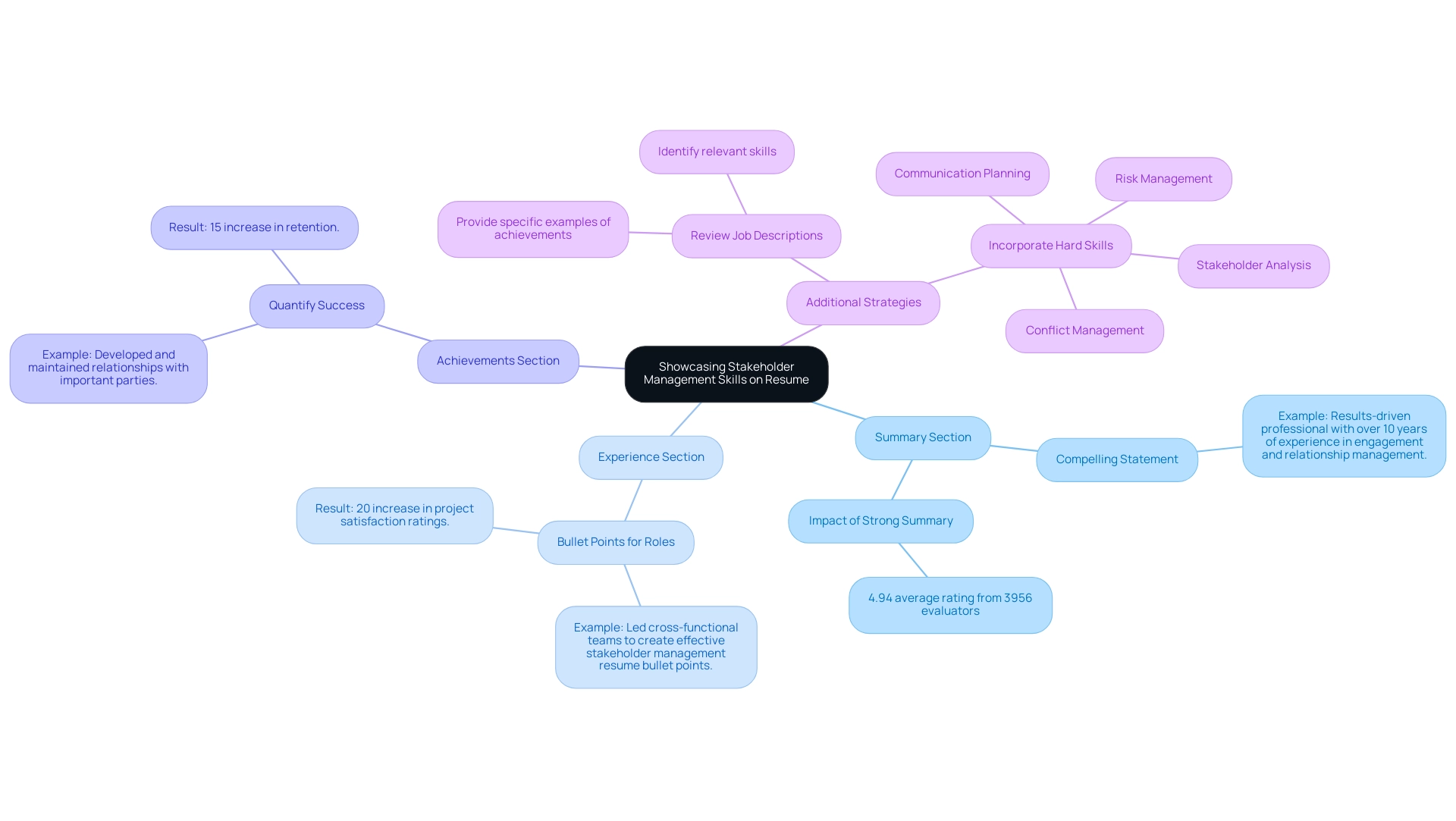
Common Mistakes to Avoid When Writing Stakeholder Management Bullet Points
When creating bullet points for management positions, it's crucial to steer clear of typical traps that can weaken your document's impact. Given that nearly 90% of job seekers utilize mobile phones when searching for new opportunities, it's essential to ensure your application is concise and easily readable. Here are key considerations to elevate your presentation:
-
Vagueness: Specificity is crucial.
Rather than a generic statement like 'worked with stakeholders,' opt for clarity with a phrase like 'collaborated with senior executives to develop strategic initiatives.' This not only conveys your role but highlights your engagement with key decision-makers.
-
Lack of Action Verbs: Initiate your bullet points with compelling action verbs that underscore your impact. Words such as 'negotiated,' 'developed,' or 'facilitated' demonstrate your proactive contributions.
-
Overly Complex Language: Keep your language straightforward and clear.
As Bill Dew, Founder and CEO of Swapp & Associates, advises, 'Avoid a ridiculously long CV because recruiters and hiring managers take offense to it.' While industry jargon may sometimes be necessary, prioritize clarity to ensure your document is easily understood by a diverse audience.
-
Neglecting Results: Emphasizing the outcomes of your actions is vital. For instance, stating 'Increased participant engagement by implementing feedback mechanisms, leading to a 30% improvement in satisfaction scores' effectively showcases your achievements.
Additionally, avoid including irrelevant information that detracts from your key message. A case study demonstrated that incorporating personal details can lessen the effectiveness of a CV. By avoiding these errors, you can create stakeholder management resume bullet points that not only showcase your ability to handle relationships but also appeal to recruiters and hiring supervisors, turning your application into an engaging read.
Significantly, 95% of CV authors highlight the importance of incorporating a abilities section, further boosting your attractiveness to prospective employers.
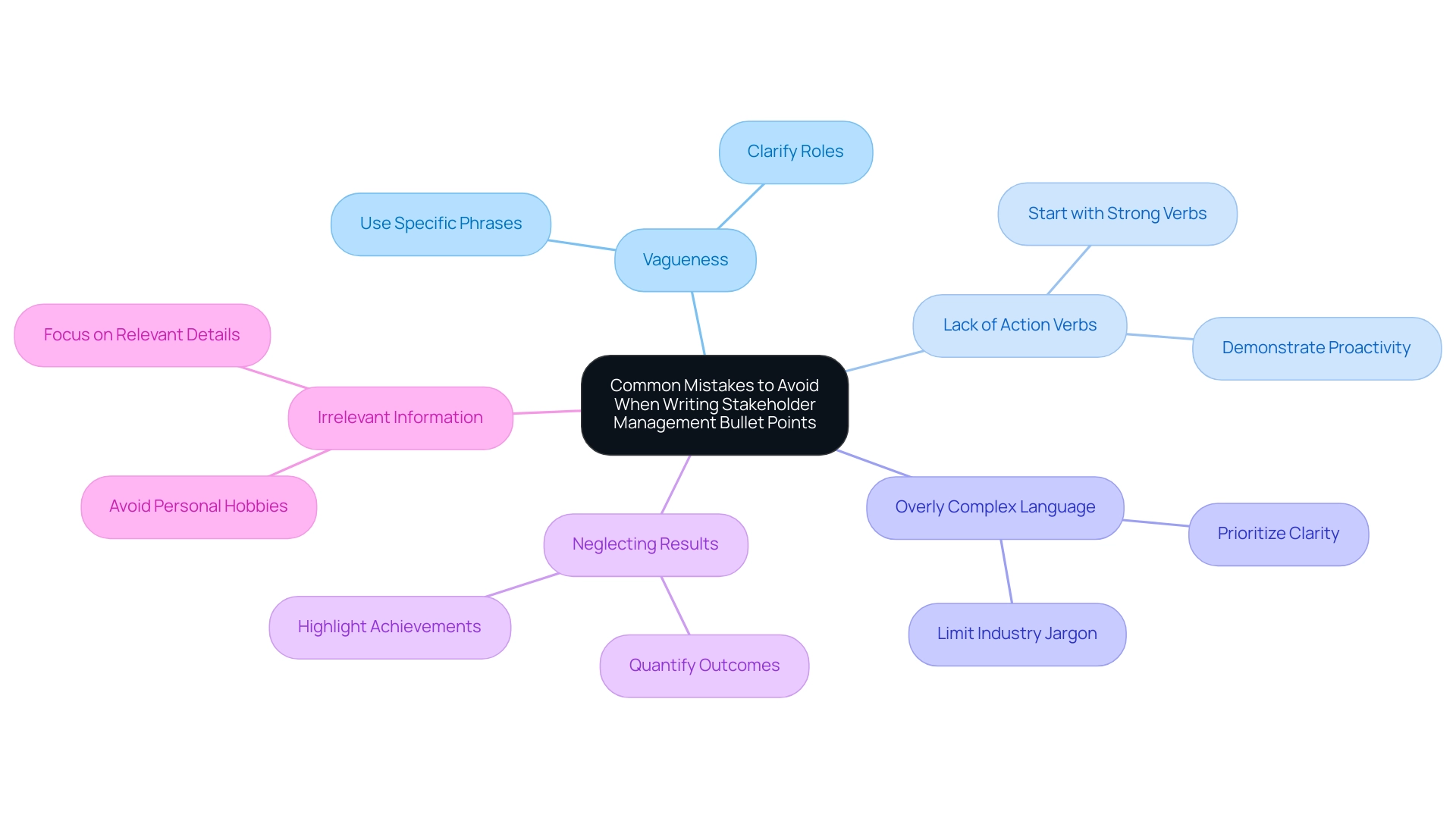
Tailoring Your Resume Bullet Points for Stakeholder Management Roles
To effectively customize your resume bullet points for management roles involving key individuals, consider the following strategies:
- Analyze Job Descriptions: Begin by identifying keywords and phrases that are crucial to management. Incorporate these terms into your bullet points to align your experience with the job's requirements.
- Highlight Relevant Experience: Focus on experiences that directly relate to the specific responsibilities outlined in the job description. For instance, if the role emphasizes 'cross-departmental collaboration,' ensure your bullet points clearly reflect this skill.
- Adjust Language: Utilize the language and terminology found in the job posting. This approach resonates with hiring managers and demonstrates your understanding of the role's specific demands.
- Showcase Relevant Achievements: Prioritize achievements that align with the employer’s objectives. If the job emphasizes involvement from interested parties, be sure to include stakeholder management resume bullet points that highlight concrete examples of how you successfully managed those relationships.
Additionally, including a cover letter can significantly enhance your application, as 77% of recruiters favor candidates who provide one, even when it is not required. By implementing these strategies, you enhance your chances of capturing the attention of hiring managers. Considering that only 14% of hiring professionals spend more than a minute reviewing an application, a well-tailored document is essential. This urgency is further supported by the case study titled 'Resume Customization and Attention Span,' which illustrates the necessity of customization to improve interview prospects. Remember, as one expert noted,
Short and genuine is the way to go to stand out.
This concise focus not only showcases your qualifications but also increases your likelihood of securing an interview.
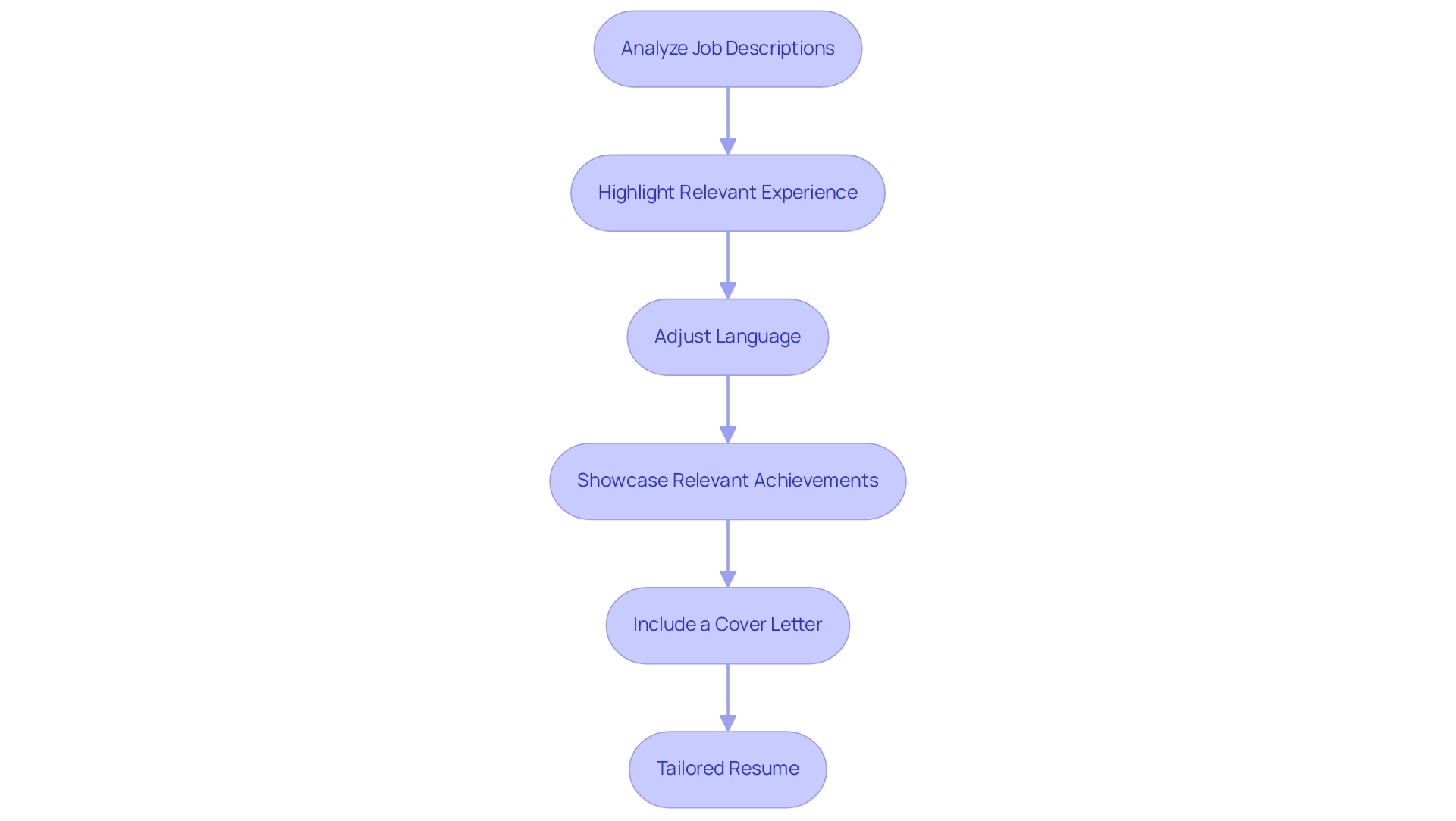
Quantifying Your Stakeholder Management Achievements for Greater Impact
To enhance the effectiveness of your resume bullet points, it is crucial to quantify your management achievements whenever possible. Consider the following strategies:
-
Use Numbers: Incorporate specific figures to demonstrate your impact clearly. For instance, you might say, 'Increased satisfaction scores by 25% through targeted communication strategies.'
This approach not only highlights your contributions but also offers tangible evidence of your effectiveness.
-
Show Financial Impact: Emphasize how your actions have directly influenced the bottom line. A statement like, 'Negotiated contracts that saved the company $50,000 annually,' showcases your ability to deliver financial results, a critical aspect for any CFO role.
-
Demonstrate Scale: Indicate the breadth of your responsibilities. For example, 'Managed relationships with over 100 stakeholders, ensuring alignment with project goals,' illustrates your capacity to handle large-scale stakeholder engagement, which can be highlighted in your stakeholder management resume bullet points.
-
Highlight Growth: If applicable, mention metrics that reflect growth, such as, 'Facilitated a 15% increase in stakeholder engagement through innovative outreach programs.'
This not only demonstrates your proactive approach but also quantifies your contributions to organizational success. By quantifying your achievements, you provide concrete evidence of your capabilities, making your application more compelling. This strategy aligns with a dominant trend, as a notable 91% of job seekers prefer a double-column format for their applications, which allows for maximizing space and presenting information in a reader-friendly manner.
Moreover, only 9% of individuals have opted for a single-column format, underscoring the shift towards more visually appealing layouts. Remember, with just 14% of hiring professionals spending more than a minute reviewing resumes, presenting quantifiable results is essential for capturing their attention. Additionally, since 47% of professionals find cover letters essential in highlighting achievements, it’s important to apply similar quantification strategies in your cover letter as well.
The work experience section remains critical, as 88% of hiring managers prioritize specific accomplishments and results, making quantifying your achievements even more vital.
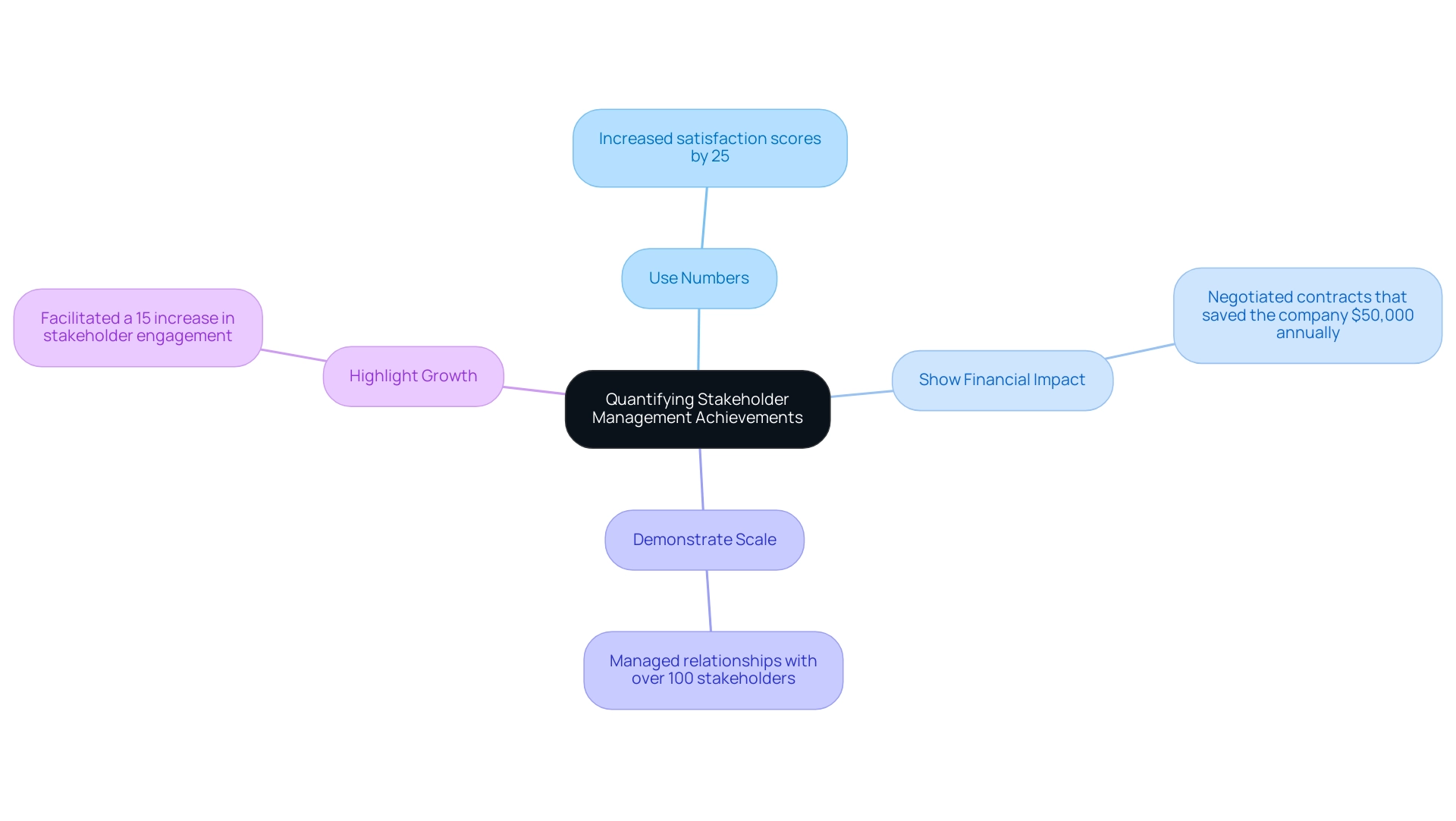
Conclusion
Crafting a standout resume that effectively showcases stakeholder management skills is essential for career advancement in today's competitive job market. Highlighting key competencies such as:
- Communication
- Negotiation
- Conflict resolution
- Relationship building
- Strategic thinking
can set candidates apart and demonstrate their value to potential employers. By using clear, action-oriented language and quantifying achievements, professionals can create a compelling narrative that resonates with hiring managers.
Implementing strategies tailored to different sections of the resume—such as impactful summaries and quantifiable achievements—enhances the overall presentation and effectiveness of the document. Avoiding common pitfalls like vagueness and overly complex language ensures that resumes remain concise and impactful, capturing the attention of busy recruiters.
Ultimately, a well-crafted resume that emphasizes stakeholder management skills not only reflects a candidate's qualifications but also positions them as indispensable assets capable of driving organizational success. By focusing on these elements, professionals can secure their place in the evolving landscape of stakeholder management, paving the way for new opportunities and career growth. Now is the time to take action and refine your resume to showcase your ability to thrive in complex environments.
Don't wait—get expert guidance today to elevate your resume and unlock new career opportunities!
Frequently Asked Questions
What key skills should be emphasized in a resume for stakeholder management roles?
Key skills to emphasize include Communication, Negotiation, Conflict Resolution, Relationship Building, and Strategic Thinking. These skills are essential for success in stakeholder management.
Why is communication important in stakeholder management?
Communication is crucial as it allows you to clearly articulate ideas to various stakeholders, ensuring alignment and understanding. Poor communication can lead to increased stress and wasted time, negatively impacting productivity.
How can negotiation skills influence project outcomes?
Strong negotiation skills can help reach mutually beneficial agreements, significantly influencing project success and enhancing relationships among stakeholders.
What role does conflict resolution play in stakeholder management?
Conflict resolution is vital for mediating disputes and finding effective solutions, which helps maintain harmony and productivity within teams.
How does relationship building impact trust in the workplace?
Establishing and nurturing professional relationships increases trust in leadership. Employees who feel their feedback is valued are more likely to trust their leaders, which fosters a positive work environment.
What is the significance of strategic thinking in stakeholder management?
Strategic thinking helps align the interests of involved parties with organizational goals, ensuring that everyone is working towards a common vision.
How should the summary section of a resume be structured for stakeholder management?
The summary section should start with a compelling statement that encapsulates your experience in engagement and relationship management, such as 'Results-driven professional with over 10 years of experience in engagement and relationship management.'
What should be included in the experience section of a stakeholder management resume?
The experience section should include specific roles where you successfully managed stakeholders, using clear bullet points that illustrate your capabilities and the tangible impact you made in previous positions.
How can achievements be quantified in a resume?
Achievements can be quantified by including metrics that demonstrate your effectiveness, such as 'Developed and maintained relationships with important parties, contributing to a 15% increase in retention.'
What additional skills should be integrated into a stakeholder management resume?
Additional skills to integrate include hard skills like participant analysis, communication planning, risk oversight, and conflict resolution to effectively handle relationships with stakeholders.
How can job descriptions assist in tailoring a stakeholder management resume?
Examining job descriptions helps identify pertinent abilities and allows you to customize your CV accordingly, ensuring it aligns with the requirements of the roles you are applying for.

